Steakhouse-Style Rib-Eyes
These steaks are about to make your kitchen smell like a five-star steakhouse, minus the $200 price tag and pretentious waitstaff.
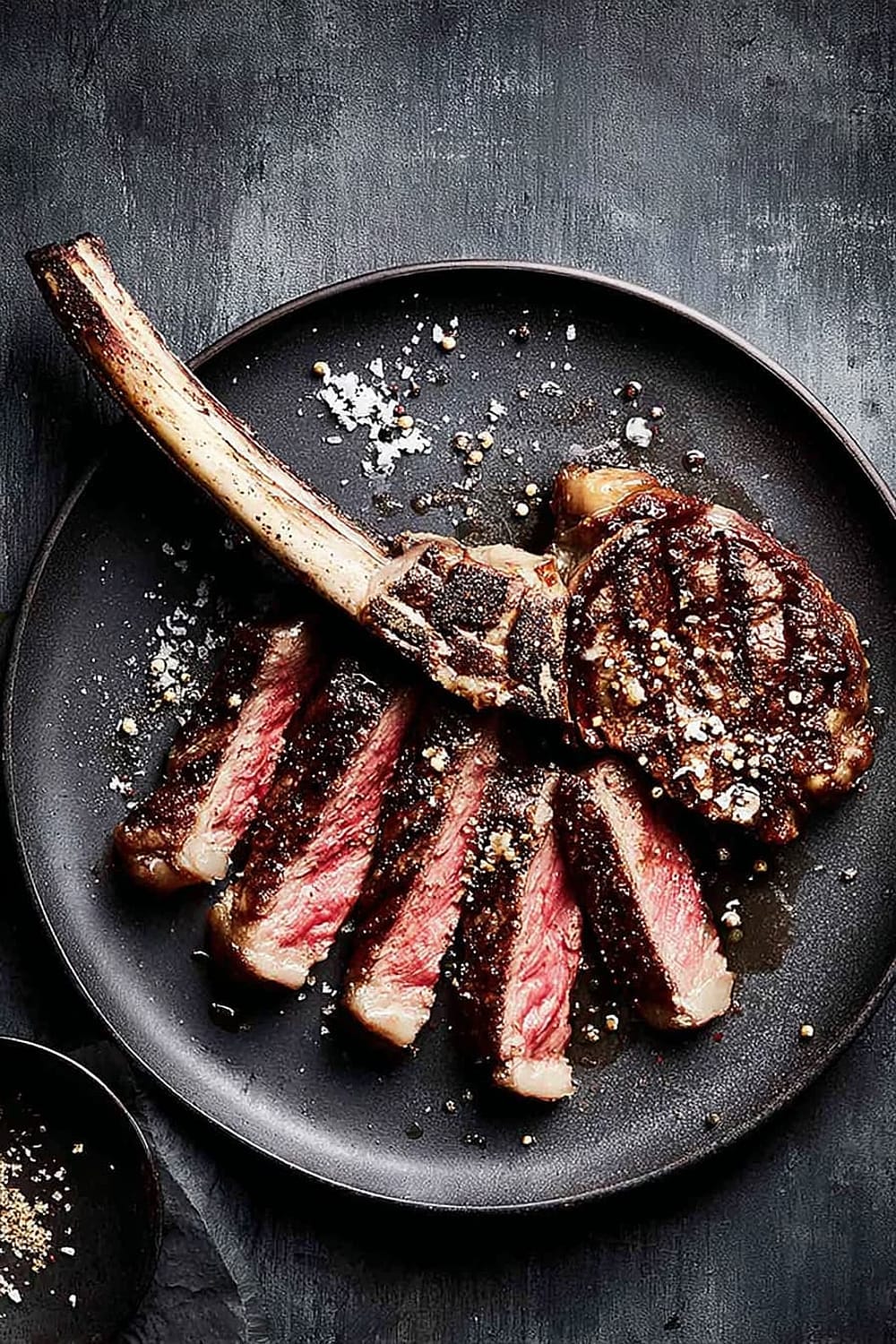
The 72-hour dry-aging process transforms ordinary rib-eyes into concentrated flavor bombs that’ll have your neighbors mysteriously showing up around dinner time.
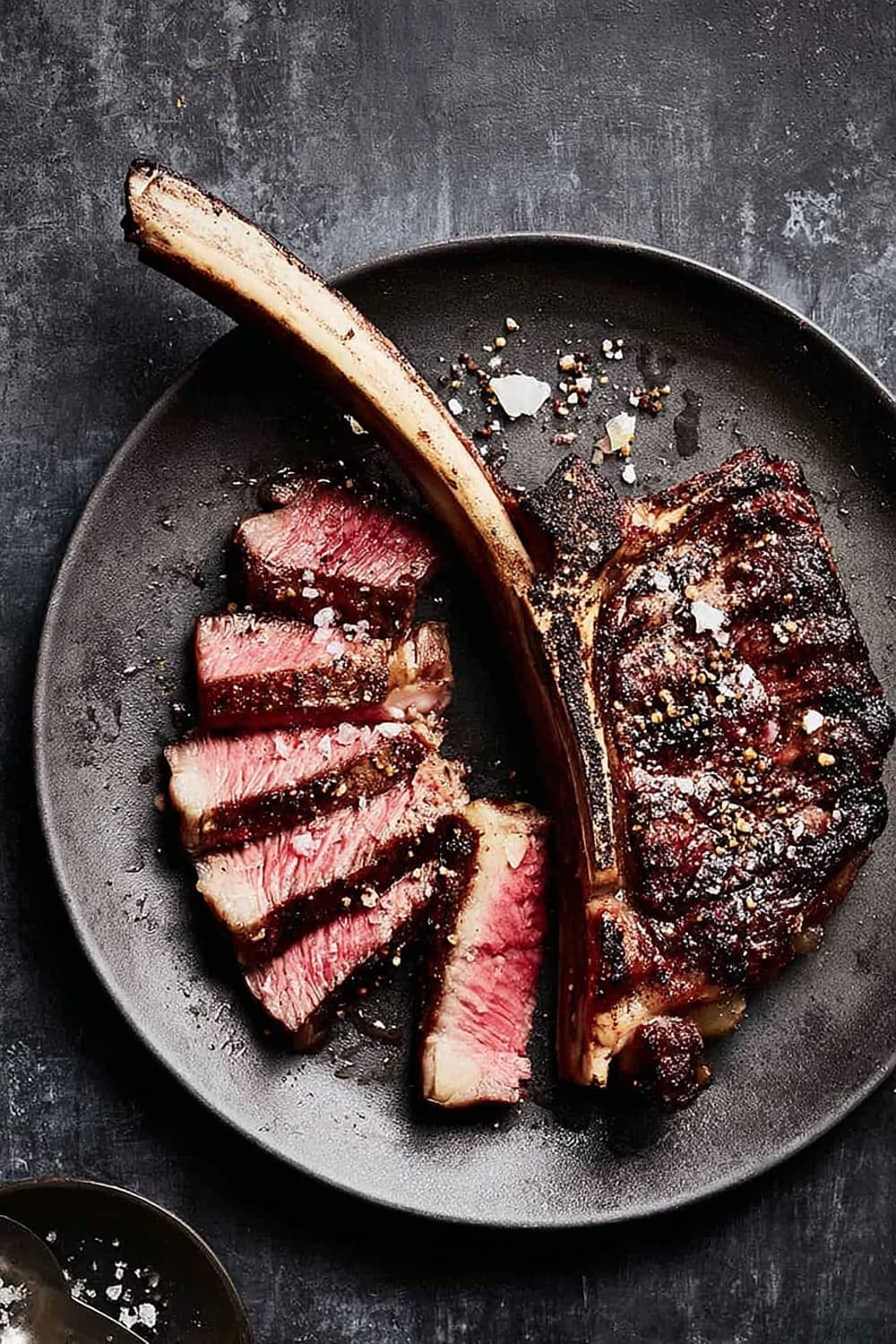
That perfect sear you get from the cast iron skillet creates a crust so magnificent, it practically deserves its own Instagram account.
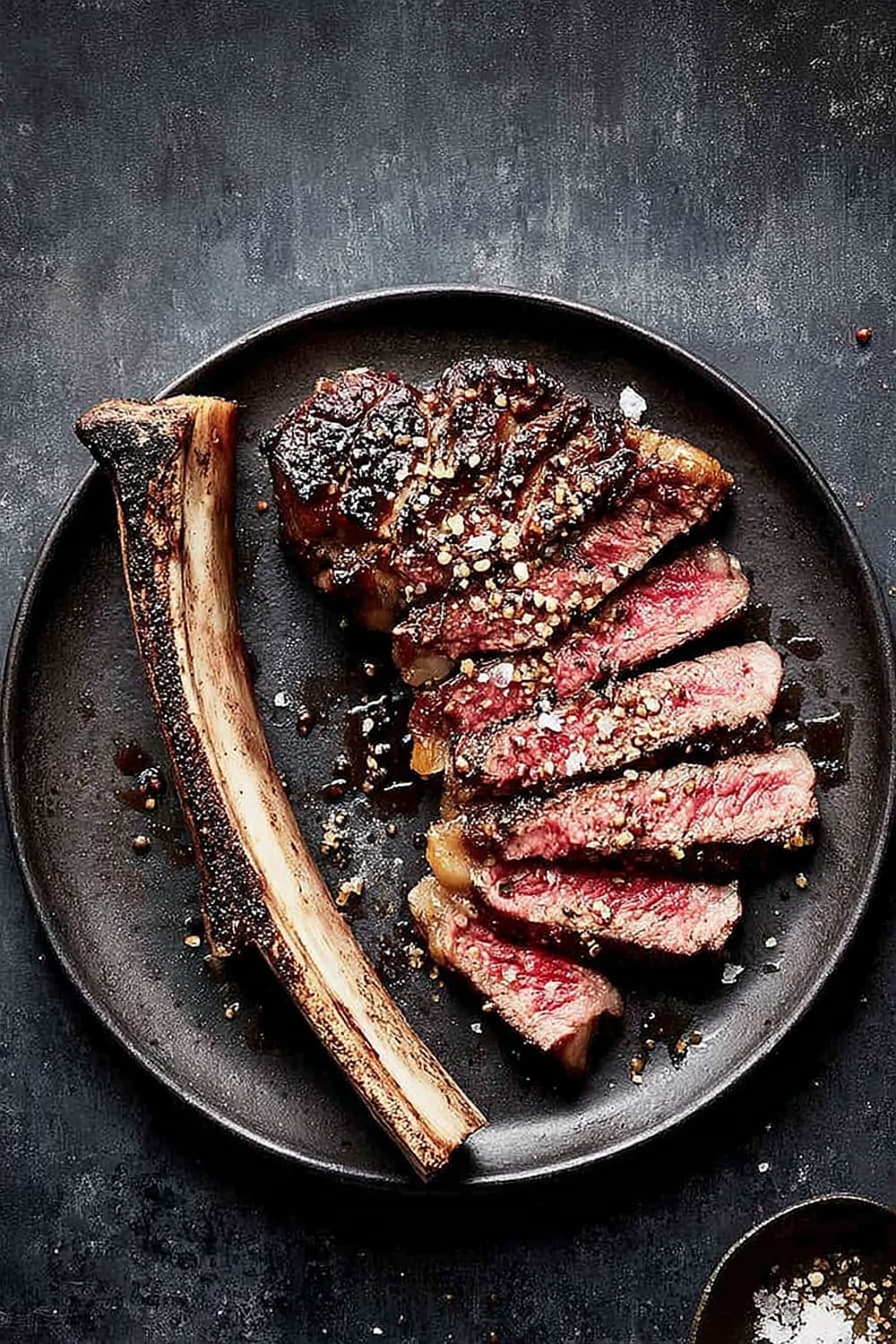
The butter basting technique is basically steak therapy – watching that golden butter cascade over perfectly cooked meat is oddly therapeutic.
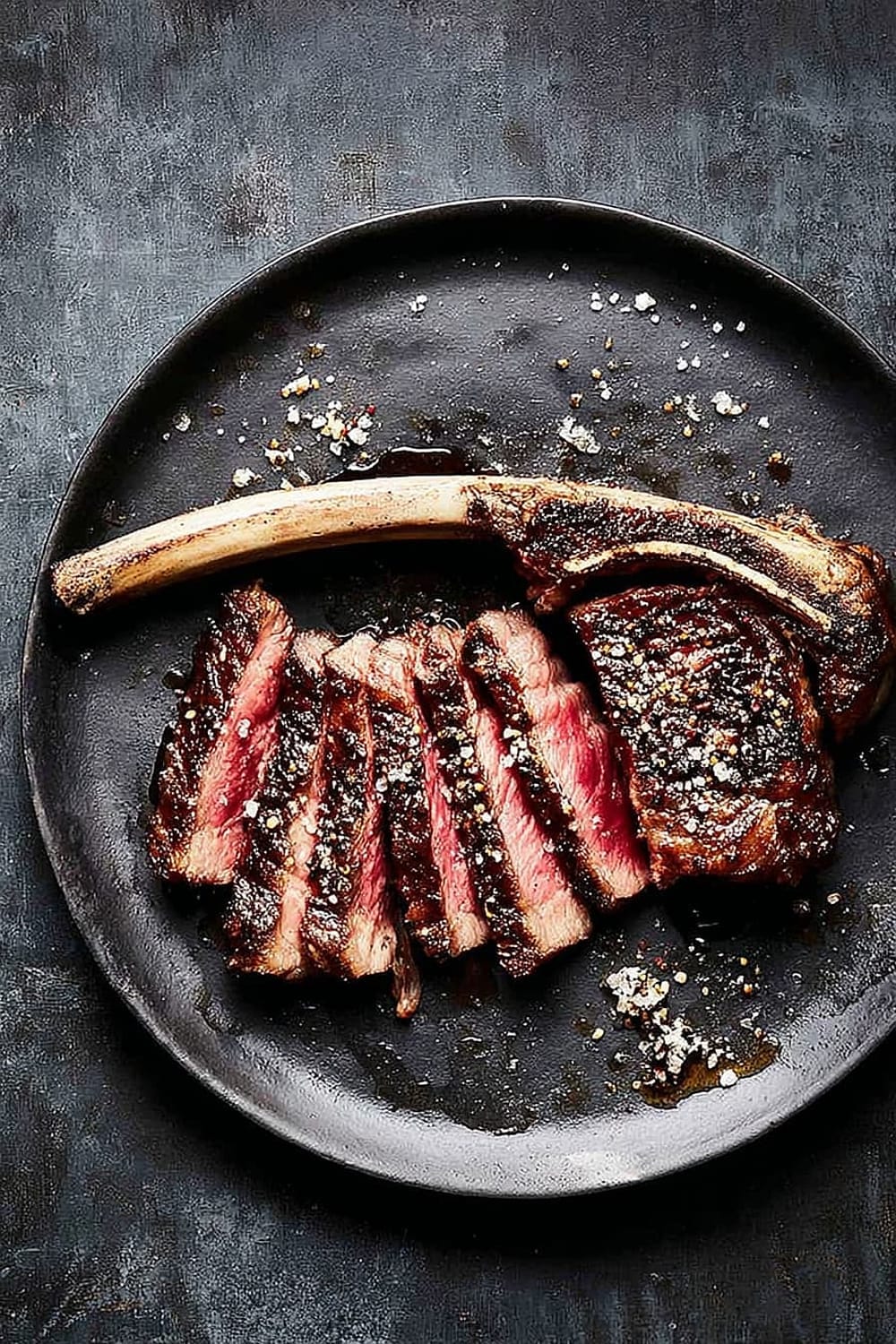
This recipe proves you don’t need a $3,000 grill or culinary school training to achieve restaurant-quality results that’ll make people question everything they thought they knew about your cooking skills.
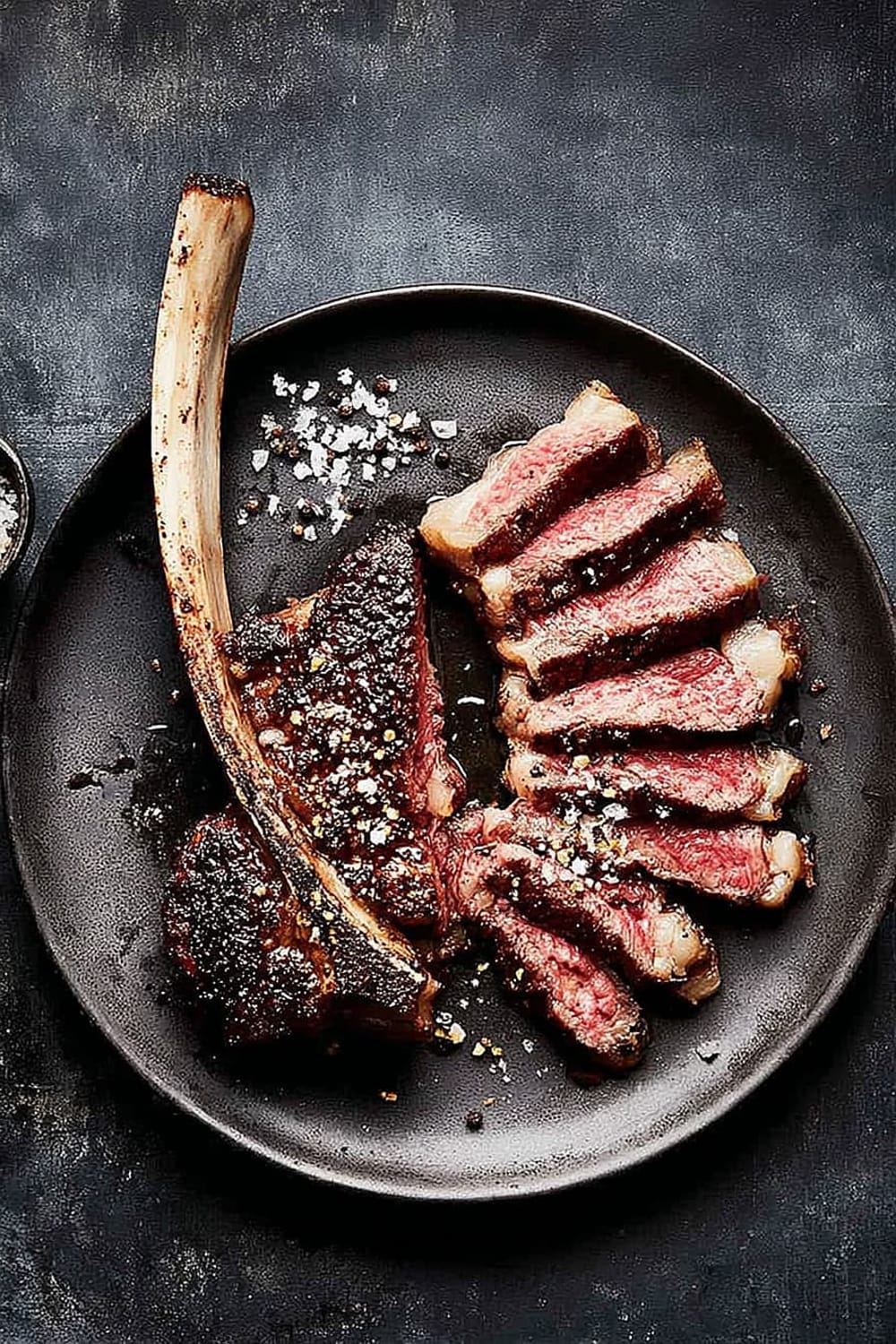
Warning: making these steaks will result in unreasonably high expectations for all future beef experiences, and you’ll probably never order steak at a mediocre restaurant again.
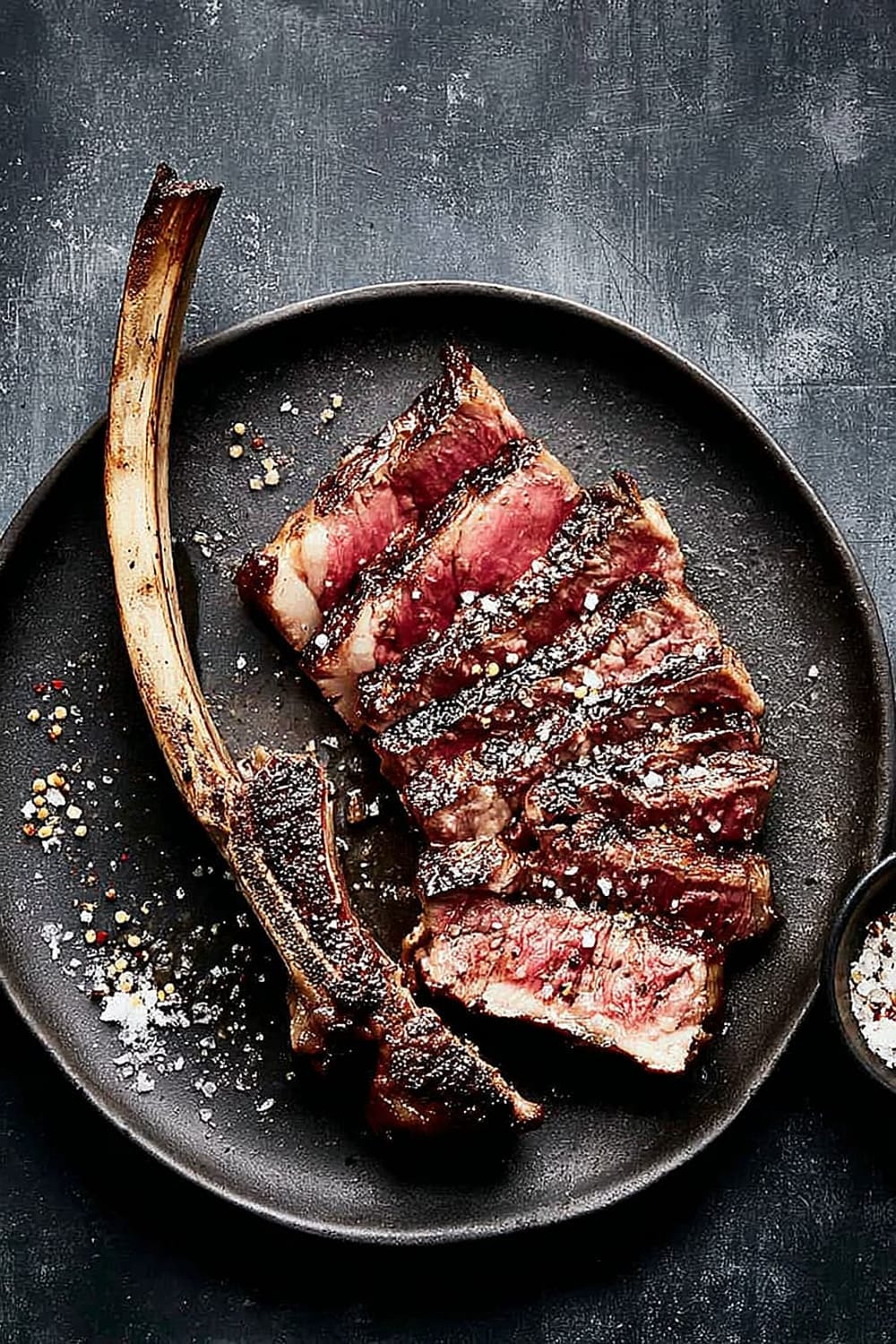
Ingredients
For the Steaks
- 1 tablespoon Diamond Crystal kosher salt
- 2 (1 1/2-pound) 1 1/2-inch-thick bone-in rib eye steaks
- 2 tablespoons grapeseed oil
- 2 teaspoons black pepper
- 1 /4 cup unsalted butter, cut into pieces
- 2 garlic cloves
- Sel gris for finishing
Instructions
Preparation and Dry-Aging
- 1 Holding the Diamond Crystal kosher salt about 1 foot above the steaks, sprinkle both sides evenly with salt in a steady stream, pressing slightly to help it adhere. This technique ensures even distribution and proper penetration of the salt into the meat fibers.
- 2 Place the salted steaks on a wire rack set inside a rimmed baking sheet. The wire rack allows air circulation around the entire steak, which is crucial for the dry-aging process. Chill uncovered for 72 hours, turning the steaks twice daily to ensure even moisture removal and salt penetration.
Pre-Cooking Setup
- 3 Remove steaks from refrigerator and let stand at room temperature for 1 hour. This step is critical – cold steaks will cook unevenly, resulting in a gray band around the edges. Room temperature steaks cook more uniformly throughout.
- 4 Preheat your oven to 400°F (204°C). Position the rack in the middle of the oven for even heat distribution.
Searing Process
- 5 Heat 2 tablespoons grapeseed oil in a 12-inch cast iron skillet over high heat. Grapeseed oil has a high smoke point, making it ideal for the intense heat needed for proper searing. The cast iron retains and distributes heat evenly.
- 6 Sprinkle steaks evenly with 2 teaspoons black pepper, pressing gently to adhere. When you see a wisp of smoke rising from the skillet, the oil is at the perfect temperature – this indicates 400-450°F (204-232°C).
- 7 Add steaks to the skillet in a single layer and cook undisturbed for 4 minutes. Resist the urge to move them – this undisturbed time allows the Maillard reaction to create that coveted golden-brown crust.
- 8 Flip steaks using tongs and cook another 4 minutes. The crust should be deep golden brown and release easily from the pan when properly seared.
Edge Rendering
- 9 Using tongs, turn steaks onto their fatty edges, leaning them against the sides of the skillet to keep stable. Cook, rolling occasionally to render the fat cap, until caramelized all over, 4 to 5 minutes. This step renders the fat and creates additional flavor while preventing chewy fat in the final dish.
Butter Basting and Oven Finishing
- 10 Place steaks flat in the skillet and add 1/4 cup butter pieces and 2 garlic cloves around the steaks. The butter will begin foaming immediately – this is normal and desired.
- 11 Transfer the entire skillet to the preheated oven and roast for 5 minutes. This initial oven time begins the gentle cooking of the interior while maintaining the crust.
- 12 Remove skillet from oven and place on stovetop over medium heat. Carefully tilt the skillet toward you so the brown butter pools at the bottom, then spoon this aromatic butter over the steaks repeatedly. This basting adds incredible flavor and helps cook the steaks evenly.
- 13 Carefully flip steaks and baste again with the brown butter. The garlic should be fragrant and golden, and the butter should have a nutty aroma.
- 14 Return skillet to oven and roast until an instant-read thermometer inserted in the thickest portion registers 120°F (49°C) for medium-rare, 4 to 6 minutes. For medium, aim for 130°F (54°C).
Resting and Serving
- 15 Transfer steaks to a cutting board and let rest for 10 minutes. This resting period allows juices to redistribute throughout the meat, ensuring maximum tenderness and flavor in every bite.
- 16 Remove bones using a sharp knife, cutting close to the bone. Separate the fatty strip from each steak if desired. Slice steak thinly against the grain – this breaks up muscle fibers for maximum tenderness.
- 17 Reassemble sliced steaks on a warmed platter, fanning slices slightly for elegant presentation. Arrange the bones alongside for those who enjoy gnawing the flavorful bits. Finish with a light sprinkle of sel gris for a final touch of mineral complexity.
Recommended Equipment and Kitchen Tools
Essential Tools (for best results)
- Cast iron skillet (12-inch) – The heavy bottom provides even heat distribution and excellent heat retention, crucial for achieving that perfect sear. Carbon steel is an acceptable alternative.
- Instant-read thermometer – Takes the guesswork out of doneness, ensuring perfectly cooked steaks every time. Digital models with thin probes work best.
- Wire cooling rack – Essential for the dry-aging process, allowing air circulation around the entire steak surface for even moisture removal.
- Rimmed baking sheet – Catches any drippings during the dry-aging process and fits perfectly with standard wire racks.
Helpful Upgrades
- Kitchen scale – For precise salt measurements and consistent results. Professional chefs measure salt by weight, not volume, for accuracy.
- Heavy-duty tongs – Long-handled, spring-loaded tongs give you control when flipping thick steaks and maneuvering them during edge-searing.
- Silicone basting brush – Makes butter basting easier and more efficient than spooning, though spooning works perfectly fine.
Nice-to-Have Options
- Infrared thermometer – Lets you check skillet temperature precisely before adding steaks, ensuring optimal searing conditions.
- Bench scraper – Helpful for transferring sliced steak from cutting board to platter without losing juices or disrupting your careful arrangement.
Recipe Variations and Dietary Modifications
Seasoning Variations
- Herb-Crusted Version – After dry-aging, coat steaks with minced fresh rosemary, thyme, and garlic before searing
- Spice Rub Alternative – Replace black pepper with a blend of smoked paprika, garlic powder, and cayenne for heat
- Coffee-Crusted Steaks – Mix finely ground coffee with cocoa powder and black pepper for an intense, complex flavor
- Mediterranean Style – Add dried oregano, garlic powder, and lemon zest to the seasoning blend
Cooking Method Adaptations
- Reverse Sear Method – Start steaks in a 250°F (121°C) oven until internal temperature reaches 110°F (43°C), then sear in screaming hot cast iron
- Grill Adaptation – Use the same seasoning process, then grill over high direct heat for 3-4 minutes per side, finishing over indirect heat
- Sous Vide Version – After dry-aging, vacuum seal and cook at 129°F (54°C) for 2 hours, then sear in cast iron for 1 minute per side
Butter Basting Variations
- Compound Butter – Mix softened butter with fresh herbs, garlic, and lemon zest before adding to pan
- Brown Butter with Sage – Add fresh sage leaves to the butter for an aromatic, nutty flavor
- Bone Marrow Butter – Replace half the butter with roasted bone marrow for ultra-rich flavor
Size Adaptations
- Individual Portions – Use 8-ounce ribeyes, reduce cooking times by 25-30%
- Sharing Style – Use one 3-pound tomahawk steak, increase all cooking times by 50%
Nutritional Information and Health Benefits
Key Nutritional Highlights
Each serving provides approximately 650-750 calories, with the majority coming from high-quality protein and healthy fats. A 6-ounce portion delivers about 45-50 grams of complete protein, containing all essential amino acids necessary for muscle maintenance and repair. The fat content, roughly 45-55 grams per serving, includes beneficial monounsaturated fats and natural omega-3 fatty acids found in grass-fed beef.
Health Benefits of Main Ingredients
Grass-fed ribeye provides exceptional amounts of vitamin B12, essential for nervous system function and red blood cell formation. The meat also contains significant levels of zinc, supporting immune function and wound healing, plus iron in its most bioavailable heme form. Garlic contributes allicin compounds with anti-inflammatory and cardiovascular benefits. The high-quality salt provides essential electrolytes without unnecessary additives. Grass-fed butter contains vitamin K2, crucial for bone health and calcium metabolism, along with conjugated linoleic acid (CLA), which may support healthy body composition.
Dietary Considerations
This recipe is naturally gluten-free, keto-friendly, and fits perfectly into paleo and carnivore dietary patterns. The high protein content supports satiety and muscle maintenance, while the natural fats provide sustained energy. The dry-aging process concentrates nutrients while reducing moisture, creating a more nutrient-dense final product. For those monitoring sodium intake, the salt can be reduced, though this will affect the dry-aging benefits.
Smart Swaps and Ingredient Substitutions
Salt Substitutions:
- Diamond Crystal kosher salt → Morton kosher salt (use 25% less due to different crystal size)
- Sea salt → Use coarse sea salt in same quantity, avoid fine sea salt which can over-salt
- Himalayan pink salt → Direct 1:1 substitution, adds subtle mineral complexity
Oil Alternatives:
- Grapeseed oil → Avocado oil (1:1 ratio, even higher smoke point)
- Canola oil → Safflower oil for neutral flavor and high heat tolerance
- Ghee → Excellent for high-heat searing with rich, nutty flavor
Butter Variations:
- Unsalted butter → European-style butter for higher fat content and richer flavor
- Grass-fed butter → Cultured butter for tangy complexity
- Dairy-free option → Vegan butter or refined coconut oil (flavor will differ significantly)
Finishing Salt Options:
- Sel gris → Maldon sea salt flakes for delicate crunch
- Hawaiian black salt → Smoked salt for additional complexity
- Fleur de sel → Premium option with subtle mineral notes
Budget-Friendly Swaps:
- Bone-in ribeye → Boneless ribeye (reduce cooking time by 10-15%)
- Prime grade → Choice grade ribeye for significant cost savings
- Strip steaks → Similar cooking method, slightly less marbling
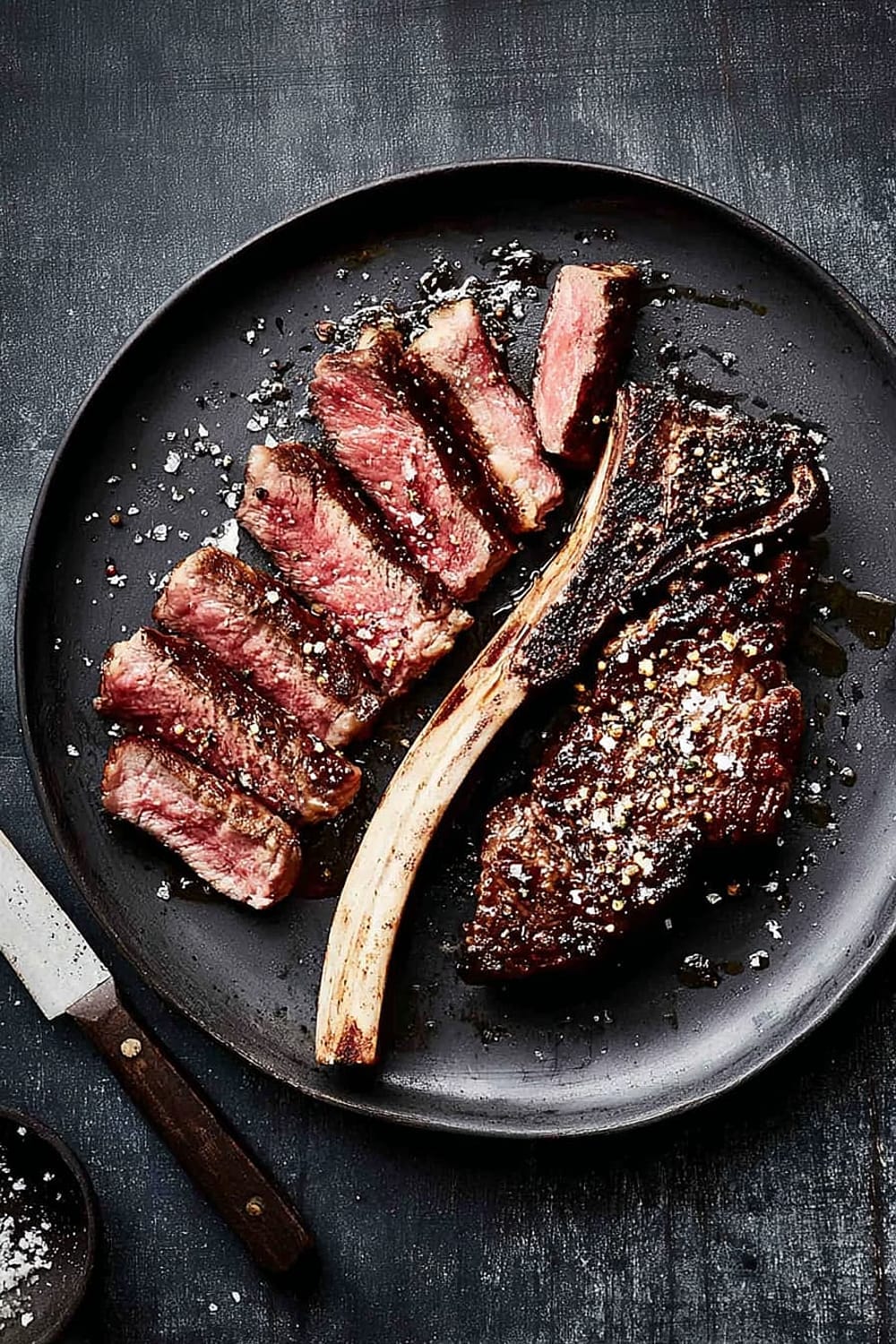
Make It Diabetes-Friendly
Carb Content Analysis:
- Total carbohydrates per serving: Less than 1 gram
- Net carbs: 0 grams (no fiber to subtract)
- Glycemic impact: Minimal – protein and fat don’t significantly raise blood glucose
Portion Control Strategies:
- Recommended serving size: 4-6 ounces cooked weight for balanced blood sugar management
- Pair with fiber-rich vegetables like roasted broccoli or sautéed spinach to slow digestion
- Include healthy fats from the butter and natural marbling to promote satiety
- Timing consideration: Consume with other low-carb foods to maintain stable glucose levels
Blood Sugar Benefits:
- High protein content helps stabilize blood sugar and increases satiety
- Zero added sugars or processed carbohydrates
- Healthy fats support sustained energy without glucose spikes
- Mineral content from quality salt supports proper insulin function
Meal Planning Tips:
- Pre-meal strategy: Consider a small salad with olive oil dressing to further slow digestion
- Post-meal activity: Light walking after eating can help with glucose metabolism
- Hydration: Adequate water intake supports proper nutrient absorption and blood sugar regulation
Total Carb Impact: Essentially zero carbohydrates makes this an excellent choice for diabetes management when portion sizes are appropriate.
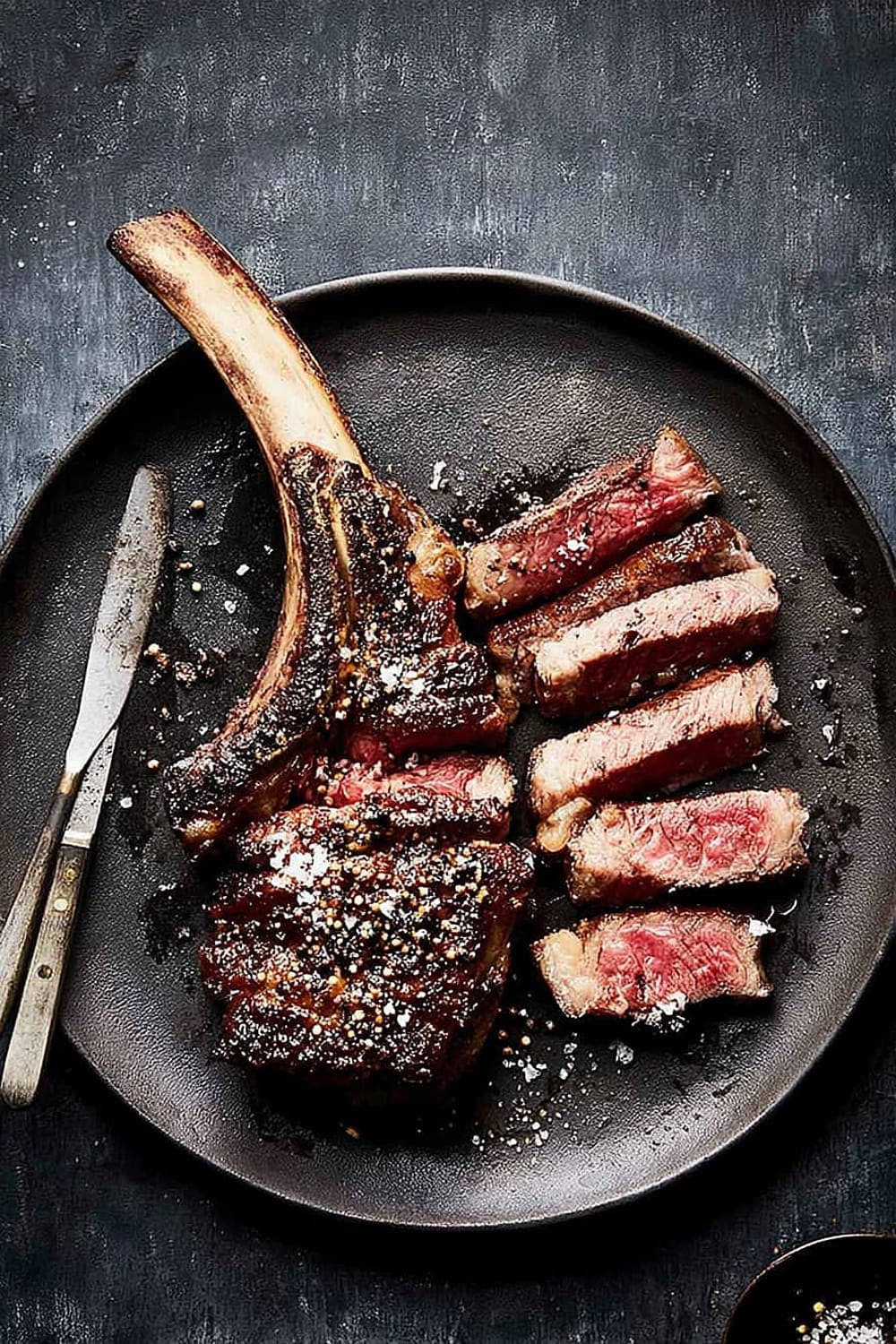
Perfect Pairing Suggestions
Wine Pairings
Bold red wines complement the rich, fatty ribeye beautifully. Cabernet Sauvignon from Napa Valley or Malbec from Argentina provide tannins that cut through the richness while enhancing the meat’s savory qualities. Syrah or Shiraz offer peppery notes that echo the black pepper seasoning. For special occasions, Barolo or Brunello di Montalcino provide earthy complexity that matches the dry-aged intensity.
Beer Selections
Imperial stouts and porters create stunning contrasts with their roasted malt flavors complementing the seared crust. Belgian dubbels offer caramel sweetness that balances the salt and pepper. IPA enthusiasts should try double IPAs – the hop bitterness cuts through fat while citrus notes brighten the rich meat.
Side Dish Recommendations
Roasted bone marrow doubles down on richness for true indulgence. Truffle mac and cheese provides creamy contrast to the meat’s texture. Grilled asparagus with lemon offers bright acidity and crisp texture. Loaded baked potatoes create the classic steakhouse experience. Sautéed wild mushrooms add earthy umami that complements the beef’s natural flavors.
Complete Meal Ideas
Start with oysters Rockefeller or shrimp cocktail for elegant appetizers. Include Caesar salad with house-made croutons for freshness. Creamed spinach and roasted Brussels sprouts provide vegetable balance. Finish with chocolate lava cake or crème brûlée for dessert decadence that matches the meal’s luxurious tone.
Pro Tips and Troubleshooting
Professional Techniques
Temperature control is everything – use an infrared thermometer to ensure your cast iron reaches 450°F (232°C) before adding steaks. Don’t overcrowd the pan; cook one steak at a time if necessary to maintain proper searing temperature. Butter timing matters – add it only after initial searing to prevent burning during the high-heat phase. Resting is non-negotiable – cutting too early results in juice loss and disappointing texture.
Common Mistake Prevention
Over-salting happens when using table salt instead of kosher salt – stick to the specified type and amount. Moving steaks too early prevents proper crust formation – trust the timing and resist peeking. Skipping the dry-aging eliminates the concentrated flavor that makes this recipe special. Incorrect doneness occurs without a thermometer – visual cues alone aren’t reliable for thick steaks.
Storage and Reheating
Refrigerate leftovers within 2 hours, wrapped tightly for up to 3 days. Reheat gently in a 300°F (149°C) oven until warmed through, about 10-15 minutes. Avoid microwaving which creates tough, rubbery texture. Slice thin before reheating for faster, more even warming.
Scaling and Make-Ahead
Double the recipe by using two cast iron skillets simultaneously – don’t overcrowd one pan. Prep timing allows for dry-aging multiple steaks together on larger racks. Compound butter can be made days ahead and refrigerated. Room temperature timing scales proportionally – larger steaks need 90 minutes to come to temperature.
This recipe transforms your kitchen into a premium steakhouse, delivering restaurant-quality results that’ll have everyone convinced you’ve been secretly attending culinary school. The combination of proper dry-aging, precise technique, and quality ingredients creates an unforgettable dining experience that’s worth every minute of the 72-hour preparation process.